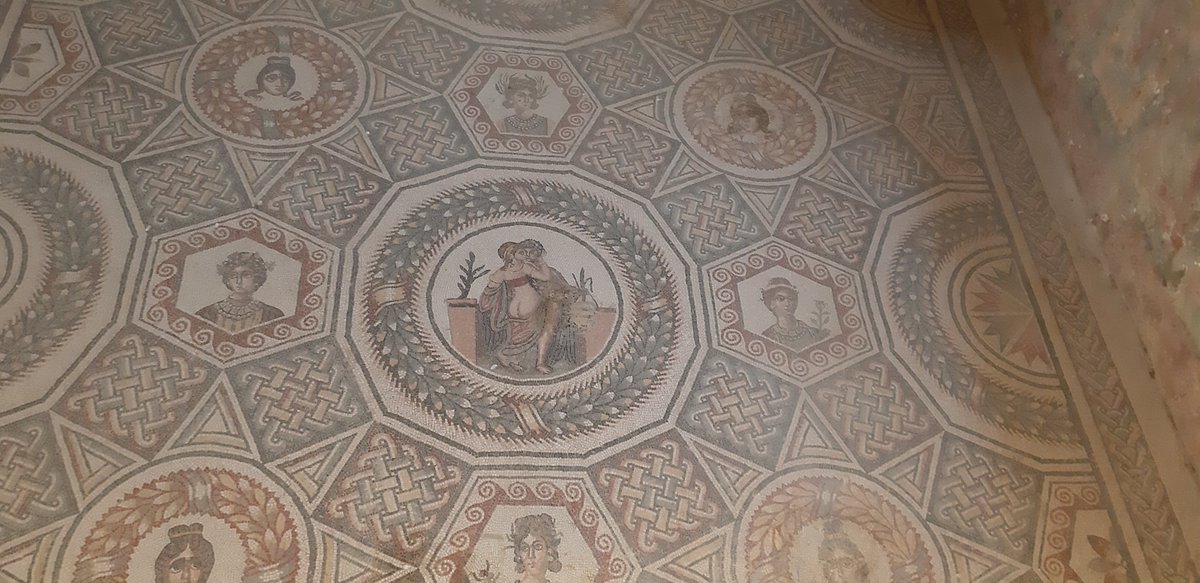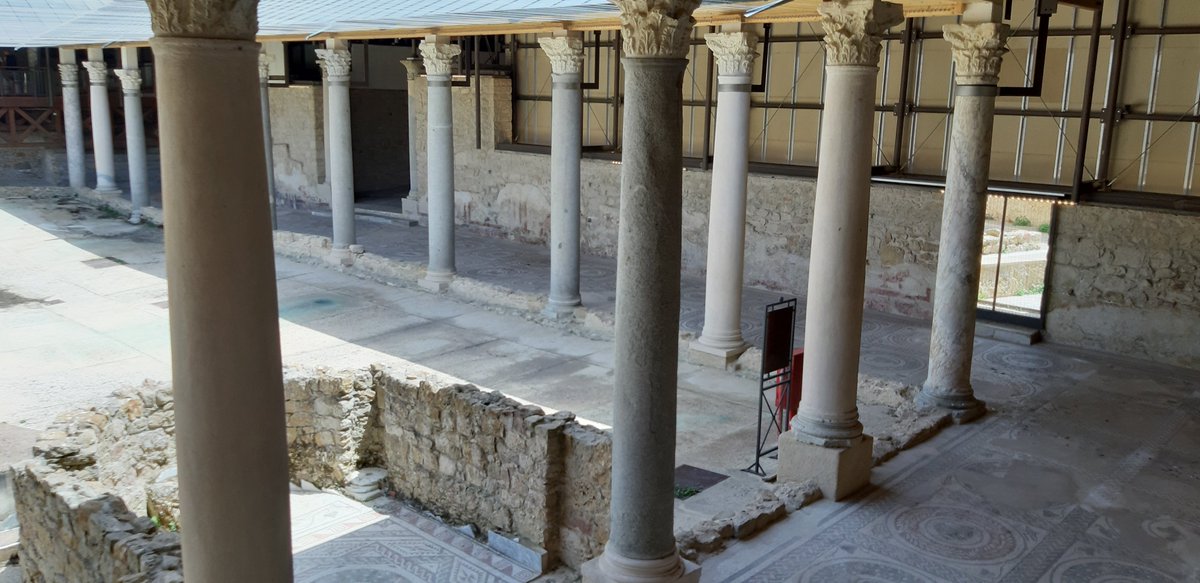The Villa Romana del Casale (IV century AD, Sicily), belonged to a member of the Roman senatorial aristocracy, probably an “Urbi Praefectus” (governor of Rome). The exceptional richness of its mosaics allowed the inscription of the Villa in the World Heritage List in 1997.
The vestibule is open to a large peristyle, whose mosaic floor presents a series of animal protomes (lions, bears, tigers, wild boars and panthers) inserted in laurel wreaths, which reverse their direction on the western side, indicating the presence of two different routes.
The private entrance to the thermae was used both by the owners and the most important guests. The mosaic depicts the domina accompanied either by her children or by her servants (blonde slaves of Germanic origin). Two house maids bring change of clothes and boxes with ointments.
This room could function as a gym. The mosaic depicts a race of quadrigae in the Circus Maximus of Rome. We can distinguish the factio russata (red), albata (white), venata (blue) and prasina (green), whose charioteer wins the race and receives a palm leaf and a bag of coins.
The room was probably a winter living room or dining room. The mosaic depicts a series of realistic and vivid hunting scenes of deer (
 ), birds (
), birds (
 ), foxes (
), foxes (
 ) and a wild boar (
) and a wild boar (
 ), including a sacrifice scene to Diana (
), including a sacrifice scene to Diana (
 ) and an open-air banquet scene (
) and an open-air banquet scene (
 ).
).

 ), birds (
), birds (
 ), foxes (
), foxes (
 ) and a wild boar (
) and a wild boar (
 ), including a sacrifice scene to Diana (
), including a sacrifice scene to Diana (
 ) and an open-air banquet scene (
) and an open-air banquet scene (
 ).
).
The huge mosaic of this corridor depicts the “venationes” or capturing live animals for exhibition in the circus spectacles in Rome. There are representations from the Far West to the Far East of the Empire: Mauretania (
 ), Italy (
), Italy (
 ), Egypt (
), Egypt (
 ), India or Ethiopia (
), India or Ethiopia (
 ).
).

 ), Italy (
), Italy (
 ), Egypt (
), Egypt (
 ), India or Ethiopia (
), India or Ethiopia (
 ).
).
This group has been identified as the dominus of the Villa flanked by two guards. He is wearing a high cingulum (red military belt embellished with badges according to their rank) and a Pannonian hat and carries a baculus, thus suggesting that he had an important military post.
This mosaic represents female athletic competitors, wearing a "strophium" (upper part) and "subligar" (lower part). The draped figure crowns the victors with a crown of roses and a branch of palm. This mosaic is laid on a previous geometric mosaic with eight-pointed stars.
The other women are taking part in athletic competitions: race with rings, long jump or discus throw. Some of them are adorned with rich jewels, which indicates their aristocratic rank.
The summer triclinium is right opposite to the winter dining room. The mosaic depicts Orpheus playing the lyre under a tree, attracting and tamping all kinds of animals. It has an educational message: music and culture can tame and dominate the irrational forces of nature.
The semicircular porticoed atrium gives access to the private apartments. The putti fishermen are using nets, creels, tridents and fishing lines with hooks. There are also maritime villas depicted in this mosaic, all with long arcades opened out onto the sea.
The antechamber presents a mosaic that portraits a chariot race, in which children are drawn by birds, symbol of the seasons. The factio russata is drawn by flamingos (spring), the albata by geese (summer), the venata by chicken (autumn) and the prasina by pheasant (winter).
In this other mosaic, children are also trying to imitate the activities of adults hunting barnyard animals. However, not everyone is having fun (
 ): one kid is bitten by a rat, while another has fallen to the ground trying to escape a giant rooster.
): one kid is bitten by a rat, while another has fallen to the ground trying to escape a giant rooster.

 ): one kid is bitten by a rat, while another has fallen to the ground trying to escape a giant rooster.
): one kid is bitten by a rat, while another has fallen to the ground trying to escape a giant rooster.
In the alcove of the same room, there are noblewomen or young flower girls, called “coronariae”, transporting and gathering roses to create flower crowns.
This mosaic represents a marine “thiasos” including Nereids, Tritons, Ichthyocentaurs and animals (fish, dragons, deer and panthers) led by Arion, who is riding a dolphin playing the cithara. The room was reserved for the dominus as a private family living room.
The Nereids display rich jewellery and wear their hair in the helmet and turban styles of the end of the 3rd century-beginning of the 4th century AD. Arion is wearing a Phrygian cap (pileus) originally from Asia Minor, which refers to the eastern origin of the character.
The antechamber to the northern apartment presents a mosaic of Ulysses offering wine to Polyphemus. The scene takes place in the cave of the giant.
The alcove houses the mosaic of the embrace of Eros and Psyche. The busts of the four seasons are shown in the hexagons – counter-clockwise: Summer, Autumn, Winter and Spring. The scene symbolises an eternal love that overcomes the passage of years and changes in appearance.
This is the end of this #thread on the luxurious mosaics of the Villa Romana del Casale. All the information is based on the superb panels spread throughout the rooms. The pictures, which are not always that nice, are mine.
Aquí te cuento este #hilo en castellano: https://twitter.com/cinnabarim/status/1292128536007004162?s=19

 Read on Twitter
Read on Twitter













































